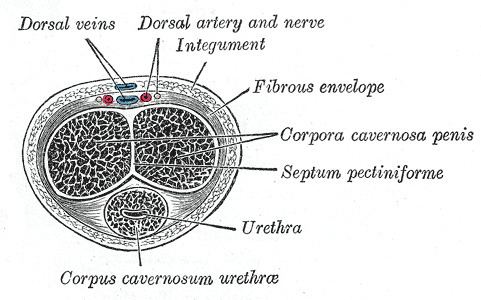Dorlands/Elsevier t_22/12831755 | FMA 19630 | |
 | ||
Latin tunica albuginea corporum cavernosorum, tunica albuginea corporis spongiosi TA A09.4.01.017A09.4.01.018 | ||
The tunica albuginea is the fibrous envelope of the corpora cavernosa penis. It consists of approximately 5% elastin, an extensible tissue that is primarily made up of the amino acids glycine, valine, alanine, and proline. The majority of the remaining tissue is collagen, which is made up of lysine, proline, glycine, alanine, and other amino acids.
The tunica albuginea is directly involved in maintaining an erection; that is due to Buck's fascia constricting the deep dorsal vein of the penis, preventing blood from leaving and thus sustaining the erect state.
The trabeculae of the tunica albuginea are more delicate, nearly uniform in size, and the meshes between them smaller than in the corpora cavernosa penis: their long diameters, for the most part, corresponding with that of the penis.
The external envelope or outer coat of the corpus spongiosum is formed partly of unstriped muscular fibers, and a layer of the same tissue immediately surrounds the canal of the urethra.
